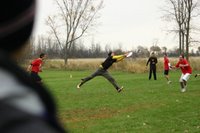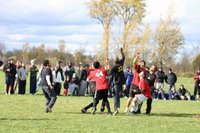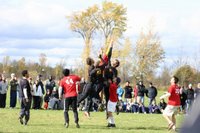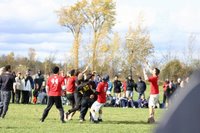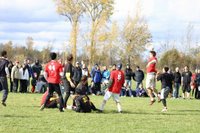Hey Folks,
After discussing throws, it's time to look at the second half of the equation - the catch. In this post we're going to talk about what I call the wheel of catches.
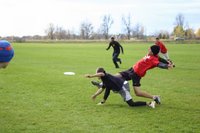 Pictured Above: Jeremy Shaki just misses a foot block on Scotty Nichols throw to Inian Moorthy. This was taken at the Canadian University Ultimate Championships.
Pictured Above: Jeremy Shaki just misses a foot block on Scotty Nichols throw to Inian Moorthy. This was taken at the Canadian University Ultimate Championships.The concept is pretty simple, but even intermediate/high level players have never been taught the proper (preferred) hand position to catch a disc. In all cases, these catches are when the disc is coming directly towards you and you are cutting parallel to the path of the disc. Their are adjustments for different angles of approach and body position. This, hopefully, will start you thinking about practicing different positions to improve your catching.
To demonstrate how to catch, I like to hold a disc and move it around my body starting from above my head to below my knees and then proceeding in a circle. Let's proceed through each stage.
Above Head
We start with what I would call a steering wheel catch. Essentially anything above the head is best caught with two hands (unless an extended reach is needed) where the hand is in a position to grip like climbing a ladder. This catch position exists from above your head to just above your shoulder. To find the position for yourself, move your arms down until the wrist is starting to stretch to catch the disc. If your wrist needs to be actively stretched, then you are in a high risk drop spot, and you should be switching your catch.
Core
The core part of the body is mostly a "pancake" or "alligator" catch where both hands clap together with one hand on top and one hand on the bottom. When in the core area, miss timing this catch is not a high risk since your body will stop the disc. Many people drop the disc using this catch when the hands don't overlap properly on completion of the clap, and instead are misaligned and cause tortion.
Another option with the core is to use a reverse steering wheel (imagine holding the bottom of the steering wheel with palms facing up). This catch can be raised as high the shoulder, but is difficult to stretch out for a grab without putting considerable effort to properly adjust the wrist.
Lower body
As we proceed down the body, we move into reverse steering wheel catches since the pancake is hard to adjust with the wrists. Getting very low, there is a necessity to move from two hands to a one hand reach, or preferably, a knee slide catch or layout. Both knee slide and layout are advanced skills that are hard to learn and teach, but are great options to successfully catch low throws.
Circling the outside
When the disc is away from the core, then in most cases the catch needs to be made with one hand in a steering or reverse steering grip. The shoulder tends to be the point at which you switch between the two catches. Above the shoulder is a steering wheel catch, and below the shoulder is a reverse steering wheel catch.
There is also an option to bring the second arm across in some cases to make a hybrid steering wheel and pancake catch.
As a player, it is important to develop all these catches, and probably more important to be able to quickly choose the proper catching position of the arms. Also, it is important to analyze where your switch points are. These are the points where one catch is preferable to another.
PJ






























